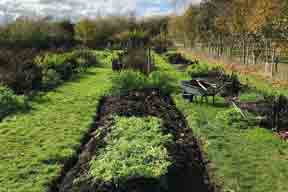Gardening in December

So what are we doing in the garden this month - in between cutting willow and making Christmas wreaths?
Well, mulching continues… 750 running metres of metre wide beds are mulched a barrow load at a time until the whole garden’s covered. And while we mulch we rearrange, defragging the garden so that it’s more organised, and each self-sown cerinthe (for example,) is corralled with its siblings, so that we spend less on seed next season, and walk less distance, and can generally be more efficient.
We have space still for a few more plants, and so I may have a little (ahem!) list of shrubs to order too to go with the new dahlias and roses. Next season we’ll make a few new beds (seriously, here I do mean just a few) to make more use of the space we have. The gardens at Common Farm Flowers are maturing now (we’ve been here for fourteen years - when we arrived the seven acres were an empty field with a low hedge round the edge, and a house in the middle.)
We’ve made what’s becoming a woodland garden, with about half a mile of hedging now fifteen feet high, sections of orchard, and willow and wildflowers, and hundreds of trees, and in the spaces between the cut flower patches nestle, protected from wind. There are much MUCH more efficient ways to lay out a flower farm, but for us the point of this exercise is that in making a cut flower farm we also make a haven for wildlife. And so when I say we make more beds and defragg to make the space work more efficiently, that’s taking into account our rather unusual reasoning. As a result we have made what’s becoming an interesting garden, certainly worth coming to see… (a place booked on a garden tour here makes a good Christmas present too!)
When you buy from Common Farm Flowers you’re supporting a wildlife garden in which the whole point is that there is no mono culture, that there is space for the wild, that there’s plenty for the bees and butterflies and therefore birds and so on to eat. The gardens at Common Farm Flowers are an example of how, within such a wild structure, a way can be made to make a living. We work on a much much smaller scale than the wilding project at Knepp (see Isabella Tree’s astonishing book on the subject, published by Picador last May,) but we’re an example of how one can create a wildlife garden which can also work commercially. When we teach workshops we take care to demonstrate how, even on an ordinary domestic level, wildlife gardening is a) possible, b) very attractive and c) can make a massive difference to an environment. On the subject of wildlife gardening, I’ve started (always late to the party, I know!) a bit of a vlog on youtube, where I show how we work with the wildlife, and how the wildlife kindly benefits us in return. Do have a look and subscribe.








